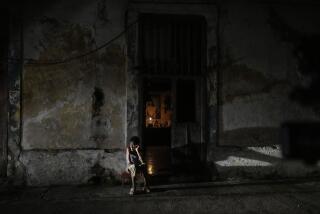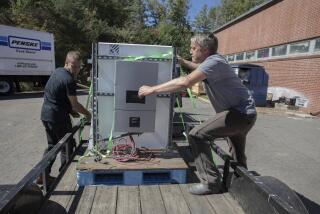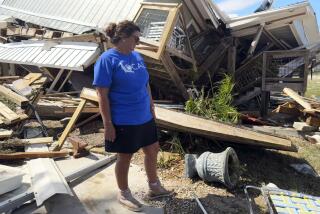Power, Shelter, Holiday Cheer in Short Supply on Typhoon-Ravaged Guam
AGANA, Guam — Their roof was somewhere out in the jungle, and every door in their house had been blown away. But in the wake of Typhoon Paka, the Padama family considered themselves lucky, for they had what everyone wanted: electricity.
With a portable gas generator humming by the wreckage of what had, until Tuesday, been their tin-roofed home, the family counted their blessings and decked their eaves with Christmas lights.
“Why not just put the decorations up to show our Christmas spirit?” said 41-year-old Doris Padama, stringing sparkling white lights and glancing over at the four children and three grandchildren whose lives were miraculously spared in last week’s catastrophe.
As this remote tropical island struggled to pick up the pieces in the aftermath of the typhoon, the good news was that there were no deaths and that the storm victims were upbeat. The bad news was that normalcy is not expected to be restored for months.
Thousands of people have been left homeless, and officials said electricity won’t be fully restored until well into next year. Although President Clinton has declared the island a federal disaster area and military flights have brought relief, widespread looting has been reported and tales of hoarding and price-gouging are pouring in to authorities.
On the northern part of the island, which bore the brunt of the storm, residents were struggling to repair homes that exploded in winds of up to 236 mph. Some have set up camp in makeshift huts cobbled together from wooden pallets and scraps of carpet. More than 2,000 have fled to shelters, authorities said.
The Padamas were among the luckier survivors: At least their wood-framed home still had walls. Throughout the 12-hour storm, Doris Padama had huddled with her children and grandchildren while the wind shrieked and her husband, Romeo, held the door closed with his bare hands.
On Saturday, they were making do with a trash can for a toilet and an overturned mattress for a door. The Christmas lights were a brief indulgence, they said, and won’t be on for long; they’re expecting that they will have to rely on their generator at least until spring.
“Some of these houses won’t come back on line for six months,” said Ricardo S. Unpingco, general manager of the Guam Power Authority. Although phone service was restored quickly, the entire island lost power after flooding knocked out four power plants and the winds snapped concrete power poles.
Unpingco said the winds spared only one power plant, and what electricity it is able to generate is being routed to Guam Memorial Hospital, the island’s only nonmilitary hospital. On Saturday, repair crews turned their attention to two plants that lost roofs. Power in those stations was expected to be restored in two to three weeks, Unpingco said.
“We’ve got to get those powered up before we can think about distribution,” he said.
Repair crews, trucks and 200 power poles were arriving this weekend from the neighboring island of Saipan. The Guam government is hoping additional materials and workers can be flown in from Hawaii, using military aircraft.
Nonetheless, even after the repairs are completed, many residents of this rural village will have to perform major repairs and pass inspections before the public utility will agree to provide electricity again.
Concerned about fire hazards implicit in the legions who are making do with jerry-built shacks, utility officials have warned homeowners that they won’t turn on the juice for houses that have not been rebuilt to conform with fire codes. In some remote areas, residents were told they might have to erect their own utility poles.
Unpingco said he hopes to get electricity to 10% of the island in two weeks, have half the island served a month later and have 80% restored in three months.
Meanwhile, the line between the island’s haves and have-nots has been reduced to a single item: the portable generator. Without the gas-powered devices, families watched helplessly as the tropical heat ruined the contents of refrigerators. Those with generators passed their nights in well-lit living rooms cooled by portable fans. Those without huddled, sweating, around dying flashlights, listening to the roar of other peoples’ generators and wondering where they’d find more batteries.
In the more populated areas, stores were sold out and drawing up waiting lists for generators. One model that normally sells for about $900 was going for $1,500 or more.
Tony Koiwa said he spent most of the day Friday hunting for a generator, wading through long lines of cars that inched through intersections controlled by National Guardsmen. He scoured seven stores and found nothing but waiting lists.
*
“It would be nice just to have one to keep the refrigerator going,” he said. “Spending money every day to eat out is going to get expensive.”
Guam stores, including the world’s largest Kmart, were also running low on ice, candles, batteries, butane and other supplies. Many service stations had already run out of gas by Saturday, and those that remained open were jammed with long lines of cars.
The Guam attorney general’s office was being flooded with complaints of price-gouging.
Bernie Alvarez, the office’s consumer advocate, said most complaints were of retailers raising prices on such staples as gasoline, candles, batteries and bottled water.
“Some of [the prices] have basically doubled,” Alvarez said.
Guam law prohibits retailers from raising prices during a typhoon and for 72 hours after an all-clear notice. That period ended Saturday afternoon, and the governor is now pleading with businesses to hold the line on prices.
Meanwhile, the Guam Department of Public Health and Social Services announced that it will set up stations Monday to distribute emergency food stamps.
But for the most devastated families, it is unclear whether that will be enough. Some, like Virginia Mendiola Patdu, lost everything and lack the means to rebuild.
Patdu said her tin-roofed home was destroyed. Nothing was left after the storm except one wall with a bathroom cabinet attached. For the last five days, she and her seven family members have searched for pieces of the house.
“All my stuff flew,” the 67-year-old Patdu said.
The home she’d lived in since 1975 was gone, and the family has no insurance and no money, she said. They have thrown together a 10-by-12-foot shed from the ruins and stuffed it with the few possessions they could find.
Patdu said she is afraid she’ll lose what little she still owns to looters if she joins the throngs at the shelters. So she and her 62-year-old husband plan to live in the shed, without power or water, until federal assistance arrives.
More to Read
Sign up for Essential California
The most important California stories and recommendations in your inbox every morning.
You may occasionally receive promotional content from the Los Angeles Times.










